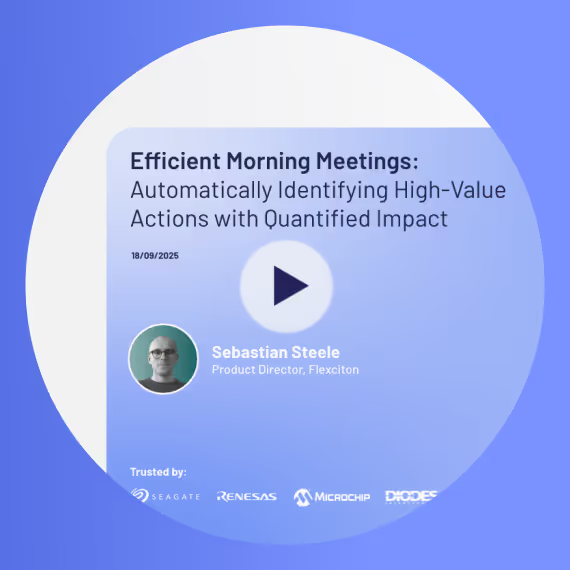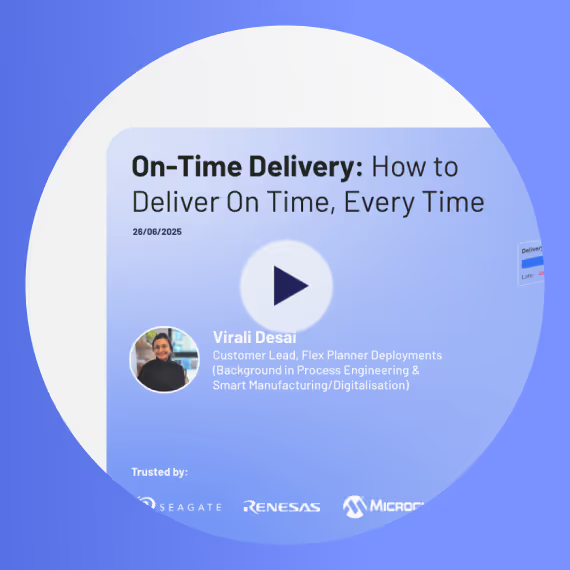We already use a dispatch system, why would we need Flexciton?
Flexciton optimizes scheduling to provide much greater performance than standard dispatching methods. Typically, dispatch systems use a rule-based approach to make decisions at a tool. When implemented, our software uses hybrid-optimization technology to calculate schedules and send them to your dispatch system for execution.
Since Flexciton software understands the current fab state across multiple toolsets, it optimizes decisions accordingly. It has the ability to adapt to an ever-changing fab environment, with no need to update the algorithms, even when significant changes occur within the system.
What makes Flexciton different from other scheduling systems?
Flexciton engineers have developed a hybrid-optimization technology, making our scheduling solution unique across the industry. It offers superior performance compared to broadly used heuristic or rules-based algorithms. For more details about our technology and solution, please download our white paper.
How can I test Flexciton's solution?
We offer a number of different ways to experience our solution at no cost, before expecting you to make any formal commitments:
- You can request a software demo, and one of our experienced consultants will schedule a demo session with you. This will help you to understand what are the features and functionalities of the system.
- You can request a Data Analysis, where our engineers, using our analytical tools, can identify key areas where efficiency can be improved. The results can be delivered within a few weeks.
- You can request an offline trial of the solution on a selected toolset (Proof Of Concept). Based on the findings from the Scheduling Performance Analysis, we can determine which toolsets should be optimized first and then test the performance offline. Then, using our software we would run a number of optimization scenarios for the troubled areas of your fab.
What type of data is required in order to use Flexciton's technology?
Our software can be easily integrated with your existing MES, as well as your local dispatch system to execute schedules. In particular, Flexciton requires ‘moves’ data from your MES, maintenance data (CMMS) as well as top-level planning data, such as due dates or priorities. Additionally, we model some constraints using configuration files (where the format of these files are provided).
What if my fab has unique constraints on some tools?
Flexciton can be configured to model many of the common fab constraints, ranging from changeover sequencing for Implanters, through to reticle scheduling for Photolithography. However, if you have unique tool constraints - we can build these in for you.
How do I use the software?
Once implemented, Flexciton’s scheduler works behind the scenes to keep the factory fed with optimal schedules every few minutes. Specific users can access the Flexciton web application to view the Gantt chart, generate alternative scheduling scenarios and change the optimization weights/parameters. Request a demo to learn more.
How is Flexciton's software hosted?
Flexciton favours cloud deployment and it is the most common deployment choice for our clients. However, on-premise is also an option if required. Get in touch with us for more information.
A
Advanced Production Scheduling
This term refers to the management of processes involved in the optimization of raw materials and resource capacity within a wafer fab or factory.
Agent
An optimization term that describes a piece of software that will make decisions and/or take actions in its environment in order to achieve a given goal.
B
Batch
A wafer batch, also known as a wafer lot, is a group of wafers that are processed together, at the same time.
Bottleneck
A bottleneck refers to a tool that is limiting the production capacity of a fab. This is usually caused by more wafers arriving at the tool than it can process, causing a build up of queuing WIP.
C
Capacity
Capacity refers to the maximum level of output of wafers a manufacturer can achieve over a period of time.
Cycle Time
Cycle time is the total amount of time taken to complete the manufacturing, from start to finish, of a single unit i.e., one wafer.
D
Dispatch System
A system, often referred to as real-time dispatch (RTD), that is used by chip manufacturers to dispatch wafers onto tools using basic heuristic rules such as “first in, first out”.
E
Etching
In wafer fabrication, etching refers to any technology that will selectively remove material from a thin film on a substrate (with or without prior structures on its surface) and by this removal create a pattern of that material on the substrate.
F
Fab
Semiconductor processing facility which turns silicon wafers into integrated circuits.
Furnace
Furnaces, also known as diffusion furnaces, are heated tubular spaces used in the manufacturing process of semiconductors. They are used to add doping impurities into high purity silicon wafers, thereby creating embedded semiconductor devices.
G
Global Scheduling (Fab-wide)
Global scheduling is a capability of Flexciton’s advanced scheduler whereby the optimizer is able to take into consideration the entirety of the fab – such as the state of toolsets further down the production line.
H
Heuristics
A heuristic is any approach to problem-solving that uses a practical method or various shortcuts in order to produce solutions that may not be optimal but are sufficient given a limited timeframe or deadline.
Hybrid Optimization
A unique model based on mixed-integer linear programming (MILP), using a unique combination of mathematical optimization, heuristic search and smart decomposition methods.
I
Implantation
Implantation, or ion implantation, is a low-temperature process by which ions of one element are accelerated into a solid target, thereby changing the physical, chemical, or electrical properties of the target.
M
Machine Learning
The use and development of computer systems that are able to learn and adapt without following explicit instructions, by using algorithms and statistical models to analyse and draw inferences from patterns in data.
Manufacturing Execution System (MES)
Commonly referred to as MES, manufacturing execution systems serve as the intermediary between a business system and a manufacturer's plant floor control equipment.
Metrology
Metrology is the science of measuring and characterising tiny structures and materials, and there are a number of tools and technologies within this category.
MILP
Mixed-integer linear programming (MILP) is the state-of-the-art mathematical framework for the optimization of processes and systems.
O
Optimization
The action of making the best or most effective use of a situation or resource.
On Time Delivery (OTD)
On Time Delivery or OTD refers to a key performance indicator measuring the rate of finished product and deliveries made in time.
P
Photolithography
A photolithography system undertakes a process whereby highly complex circuit patterns from a reticle are reduced using ultra-high-performance lenses and exposed onto a wafer.
Pod
Reticles are typically carried around in the factory in containers known as pods. A pod is inserted into a machine, and the machine can use the reticles in the pod.
Preventative Maintenance
Preventative maintenance keeps equipment in good condition through regular machinery checkups and maintenance tasks. These services may be scheduled according to a calendar or based on equipment operating time.
Q
Queue Time
The amount of time a batch of wafers spends waiting at a tool before it can be processed.
R
Reticle
A reticle, also known as a photomask, is a plate of optical glass with an opaque pattern on it, used in photolithography. When laser light is shone through the reticle, a pattern of light and dark is projected onto the silicon wafer.
Rules-based
A rule-based system is a system that applies human-made rules to store, sort and manipulate data. In doing so, it mimics human intelligence.
S
Scheduling
Scheduling is the process of arranging, controlling and optimizing work and workloads in a production process or manufacturing process.
Stocker
Reticles are stored in a central magazine called a Stocker. An engineer inserts a pod into the stocker, and the stocker robotically opens the pod, removes some reticles and replaces them with different ones.
Smart Manufacturing
The next-generation of manufacturing that employs computer-integrated systems, high levels of adaptability and rapid design changes, digital information technology, and more flexible technical workforce training.
T
Throughput
Throughput is the amount of wafers that a company can produce and deliver to a client within a specified period of time. The term is often used in the context of a company's rate of production or the speed at which something is processed.
Timelink
A timelink (also known as time constraints, time lag constraints, time loops or close coupling constraints) is a maximum amount of time that can elapse between two or more consecutive manufacturing process steps of a batch of wafers.
Toolset
A group of tools which can run the same recipes.
W
Wafer
A wafer is a thin disc of silicon (one of the most abundant semiconductors available worldwide) or another semiconductor material, used as the basis for creating electronic integrated circuits.
Wafer Priority
The importance placed on a batch of wafers that helps to determine which should be prioritised in order to benefit the objectives of the fab.
Wafer Step
Wafers travel along a defined route through the fab, and that route is made up of multiple steps. Generally speaking, each step is one process in one tool using one recipe.
WIP
WIP stands for Work In Progress and refers to wafers that have entered the production process but are not yet a finished product.
Y
Yield
Yield is a quantitative measure of the quality of a semiconductor process. It is the fraction of dies on the yielding wafers that are not discarded during the manufacturing process.




















